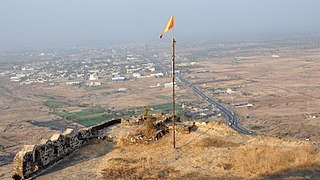
The Yadava were an ancient Indian people who believed to be descended from Yadu, a legendary king of Chandravamsha lineage.
The Dhangars are a herding caste of people found in the Indian states of Maharashtra, Karnataka, Goa, Madhya Pradesh and Uttar Pradesh. They are referred as Gavli in southern Maharashtra, Goa and northern Karnataka, Golla in Andhra Pradesh and Karnataka and Ahir in northern Maharashtra. Some Gavlis live in forested hill tracts of India's Western Ghats. Gavli, also known as Dange or Mhaske, and Ahir are a sub-caste of Dhangar. However, there are many distinct Gavli castes in Maharashtra and Dhangar Gavli is one of them.

Dhule district is a district of Maharashtra, India. The city of Dhule is the administrative headquarters of the district. It is part of North Maharashtra.

The Shilahara/Shelara Kingdom was a royal dynasty that established itself in northern and southern Konkan in 8th century CE, present-day Mumbai and Southern Maharashtra (Kolhapur) during the Rashtrakuta period.

The Abhira kingdom in the Mahabharata is either of two kingdoms near the Sarasvati river. It was dominated by the Abhiras, sometimes referred to as Surabhira also, combining both Sura and Abhira kingdoms. Modern day Abhira territory lies within Northern areas of Gujarat and Southern Rajasthan, India.
Ahir or Aheer are a community of traditionally non-elite pastoralists in India, most members of which identify as being of the Indian Yadav community because they consider the two terms to be synonymous. The Ahirs are variously described as a caste, a clan, a community, a race and a tribe.

The Seuna, Sevuna, or Yadavas of Devagiri was a medieval Indian dynasty, which at its peak ruled a realm stretching from the Narmada river in the north to the Tungabhadra river in the south, in the western part of the Deccan region. Its territory included present-day Maharashtra, northern Karnataka and parts of Madhya Pradesh, and its capital was located at Devagiri.

Ay was an ancient Tamil dynasty which controlled the south-western tip of the Indian peninsula, from the early historic period up to the medieval period.The clan traditionally held sway over the port of Vizhinjam, the fertile region of Nanjinad, and southern parts of the spice-producing Western Ghat mountains. The dynasty was also known as Kupaka in medieval period.
Bhoja II was a ruler in medieval India, the last of the Shilahara dynasty of Kolhapur in Maharashtra. He suffered a crushing defeat at the hands of Singhana, king of the Yadava Dynasty, in 1212 CE at Umalvad. He fled and his kingdom was annexed.
Gavli, Gawli or Gavali is a Hindu caste found in the Indian states of Maharashtra and Madhya pradesh. They a part of the Yadav community.

Khandesh is a geographic region in Maharashtra, India. It was made up of present Jalgaon, Dhule and Nandurbar districts. It also said that Burhanpur District of Madhya Pradesh was also its part.

Ishwarsena was the founder of the Abhira dynasty and he started an era which later became known as the Kalchuri-Chedi era. He and his descendants whose names do not occur in the Puranas seem to have ruled over a large territory comprising Gujarat, Konkan and Western Maharashtra. His descendants ruled for nine generations.
The Abhiras were a legendary people mentioned in ancient Indian epics and scriptures as early as the Vedas. they were a warlike tribe is admitted by all. Probably they were a nomadic people as they are associated with various peoples and provinces. A historical people of the same name are mentioned in the Periplus of the Erythraean Sea. The Mahabharata describes them as living near the seashore and on the bank of the Sarasvati River, near Somnath in Gujarat.

Waghali, spelled in historical records as Vaghli, is a village in Chalisgaon tehsil of Jalgaon district in the Khandesh region of Maharashtra, India.
Simhana (IAST: Siṃhaṇa, also transliterated as Singhana; r. c. 1210-1246 was the most powerful ruler of the Seuna dynasty of Deccan region in India. He expanded his kingdom southwards at the expense of the Hoysalas, and fought the Chaulukyas and the Vaghelas for the control of the Lata region in the north. He also defeated the Paramaras of Malwa, the Shilaharas of Kolhapur and the Rattas of Belgaum. His generals subjugated several insubordinate feudatory chiefs, and the Yadava territory reached its greatest extent during his reign.

The Chudasama dynasty, a Samma branch, ruled parts of the present-day Saurashtra region of Gujarat state in India between the 9th and 15th centuries. Their capital was based in Junagadh and Vamanasthali.

The Abhira dynasty was a dynasty that ruled over the western Deccan, where it perhaps succeeded the Satavahana dynasty. From 203 CE to roughly 270 or 370, this dynasty formed a vast kingdom. The Abhiras had an extensive empire comprising Maharashtra, Konkan, Gujarat and part of south Madhya Pradesh.
Yadu is the founder of the Yadu dynasty in Hinduism. He is described to be the eldest son of King Yayati, and his queen, Devayani. He married five daughters of Nāga king.
The term Ahir is derived from Abhira, a clan mentioned several times in inscriptions and Hindu revered books. The term Ahir is often seen as synonymous with Yadav because these are two names of the same community. The British census in 1881 mentions Yadavs as Ahirs. The Mahabharata and other authori-tative works use the three terms-Ahir, Yadav and Gopa synonymous.
Yadavs in Maharashtra or Ahirs in Maharashtra are members of the Ahir/Yadav community of Maharashtra. They are also known as Gavli, Jadhav, Ahir-Rao, Ahire, etc. The 1881 census records of the British India stated that the Yadavas who in their turn are identified with the Gaolis (Gavlis) and Ahirs were the dominant race at that time.










